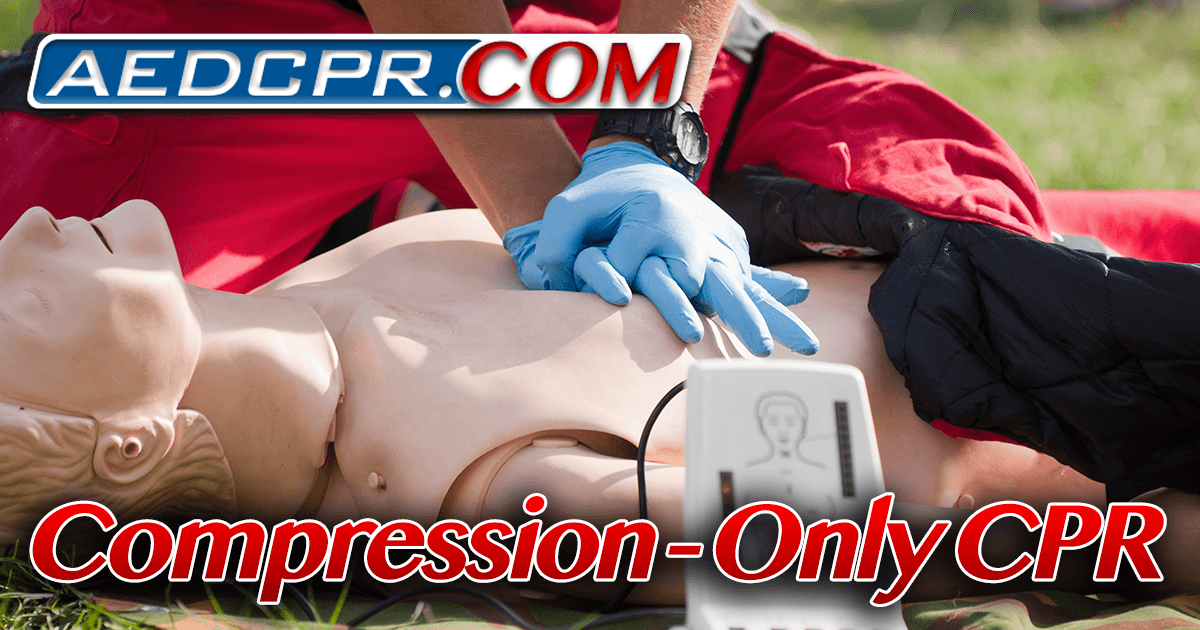
Compression-Only CPR
Compression-Only CPR provides life-saving aid to victims of cardiac arrest. It is simple to perform and is also effective in saving lives. Compression-Only CPR is a life-saving technique and can be performed by almost anyone.
What is Cardiac Arrest?
Cardiac Arrest is the sudden loss of blood flow due to a failure of the heart to pump blood effectively. A cardiac arrest often begins with a pulseless rhythm such as ventricular fibrillation. If untreated, a cardiac arrest will lead to death within a few minutes. More men suffer cardiac arrest than women. Survival for sudden cardiac arrest is less than 10%
Causes of Cardiac Arrest
About 70% of Cardiac Arrests are caused by coronary artery disease or heart disease. The most common risk factors for coronary artery disease include smoking, obesity, physical inactivity, and diabetes. Other causes include untreated hypertension, blood loss, stress, and even low potassium.
HEART ATTACK vs CARDIAC ARREST
The term Heart Attack is often confused with Cardiac Arrest. Heart Attacks are generally caused by reduced blood flow to part of the heart muscle. The ischemia, or lack of blood, will cause the pain normally associated with heart attacks. This can lead to permanent damage to the heart muscle. A heart attack may last for days. Victims experience pain and other heart attack symptoms that may or may not lead to cardiac arrest.
Clinical Death vs Biological Death
Clinical Death is when the victim’s heart stops pumping blood. Biological Death with when the victim’s brain, heart, and other organs are irreversibly damaged due to a lack of oxygen. Biological death will begin after about 4-6 minutes without oxygenated blood circulating through the body.
What is CPR?
CPR is also known as Cardiopulmonary Resuscitation. When a victim goes into cardiac arrest, the heart stops pumping blood. CPR alone rarely reverses cardiac arrest. However, providing chest compressions and ventilations will provide oxygenated blood to the victim’s organs. The purpose of CPR is to buy time until EMS arrives and can provide life-saving advanced cardiac care.
Provide compressions at a rate of at least 100 per minute. Rescue breathing is typically performed in conjunction with compressions to provide oxygenated blood throughout the victim’s body. Providing oxygenated blood by performing CPR will prevent the victim from entering biological death.
AED
Automated External Defibrillators are the biggest advancement to treat sudden cardiac arrest outside of a hospital setting. The most common pulseless rhythm is ventricular fibrillation. When suffering ventricular fibrillation, the heart will have disorganized electrical activity in the ventricles. However, knowing how to read an EKG is not necessary when using an AED. The AED will read the heart rhythm and determine if a shockable rhythm exists. If detected, an AED can provide a shock that stops the fibrillation or otherwise shockable rhythm.
Best Chance of Survival
Immediate CPR and defibrillation within 3-5 minutes give the victim the best chance of survival. When ventricular fibrillation first begins, the disorganized electrical impulses are the strongest. The stronger the electrical impulses are the better chances of survival. Electrical impulses must be present for the defibrillator to work, so it’s important to act quickly. Providing quality CPR will extend the amount of time where a defibrillator will be effective. CPR also buys time until advanced cardiac care can be administered. However, even with CPR, the chances of survival diminish every minute. Therefore it is extremely important to activate EMS as quickly as possible.
Rescue Breathing
If a victim is not breathing, you can provide life-saving oxygen by performing Rescue Breathing. You may have a victim that has signs of circulation but is not breathing.
Respiratory Arrest
It is very common in drowning or near-drowning victims. It is important to provide oxygen to the victim quickly. Without oxygen, a victim in respiratory arrest will eventually suffer cardiac arrest. Rescue breathing can be performed mouth-to-mouth, using a mask, a bag valve mask or intubation. By opening or clearing the airway of a near-drowning victim, the victim may begin spontaneous respiration.
Universal Precautions
As a rescuer, it is also important to protect yourself from infection. Universal precautions are a method of treating all blood and certain bodily fluids as if they contain Bloodborne Pathogens. Typical universal precautions include the use of non-non-permeable gloves, face shields, gowns, and one-way air valve masks. If available, use a one-way air valve mask or bag valve mask and gloves when performing CPR.
Why Compression Only CPR?
There are 2 major reasons why people do not get involved. The lack of available safety equipment is the biggest reason. Use protective equipment when performing mouth-to-mouth respiration. Bodily fluids exchanged during mouth-to-mouth respiration should be treated as if they are infected. There is also the potential for the victim to vomit during CPR. The second major reason a lack of confidence. If you have never taken a CPR class or it’s been a while, it can be intimidating. Performing Compression-Only CPR is extremely easy.
The American Heart Association and ECC recommended that chest compressions be performed without providing mouth-to-mouth respiration if protective gear is not available. A victim who goes into cardiac arrest due to a heart issue generally has about 4-5 minutes of oxygen in their blood. Performing chest compressions will circulate oxygenated blood. This will buy some time before the onset of biological death.
The most important benefit of Compression-Only CPR is that more people will do it. Almost anyone can easily perform Compression-Only CPR. Most people do not carry barrier devices such as a one-way air valve mask. If you can perform chest compressions, you can help save a life.
How To Perform Compression-Only CPR
Assess The Victim
Shake the victim and ask if they are okay. If the victim does not respond, look, listen and feel for signs of circulation. Look to see if the victim’s chest is rising, or if there are any signs of movement. Listen for breathing, gurgling or other sounds that would indicate the victim is breathing. Also, feel for signs of breathing and circulation. If a victim is breathing, you should feel the chest rise or other movements.
Activate EMS/911
If you are alone, call 911 immediately. If there is someone else available, tell them to call 911. Have them tell the 911 dispatcher that you have an unconscious adult or child. If there is an AED available, get the AED or send someone to bring it to the victim.
Position Victim
Place the victim on a hard, flat surface. A hard, flat surface allows for better chest compressions. If the victim is in bed or on a chair, carefully lay the victim on the floor. If the victim is wearing loose clothing like a jacket, remove it or open it. However, if you can’t move the victim, do the best you can.
Perform Chest Compressions
Place the heel of your palm in the center of the victim’s chest, just below the nipple line. For an adult, place your other hand on top of the hand you placed in the center of the chest. Press hard and fast with both hands. Perform compressions at a rate of 100-120 per minute. You should also compress about 2.0”-2.5” in depth. Continue providing compressions until EMS arrives and they take over.
Compression-Only vs Full CPR
Performing compression-only CPR will buy time until EMS arrives. However, it is not as effective as providing rescue-breathing in conjunction with chest compressions. As oxygen becomes depleted, chest compressions alone will not re-oxygenate the blood. So if you have a barrier device available, performing full CPR will provide a better chance of survival.
Advanced Cardiac Care
When EMS arrives, they will take over as soon as they are ready to do so. Most ambulances have the ability to use a defibrillator, provide oxygen and possibly life-saving drugs. When the victim reaches the hospital, additional life-saving treatments are available. Advanced cardiac care is available at most hospitals. This may include manual defibrillation, the ability to run advanced tests and drugs. The hospital may also be able to treat the cause of cardiac arrest.
Good Samaritan Laws
Although laws vary by state, all 50 states have Good Samaritan laws that will protect lay-rescuers. The most important thing to remember is to not go beyond your level of training. A good example of going beyond your level of training would be to administer drugs.
Some states have Duty-to Act laws. These laws require that you give assistance. Once you begin to provide assistance, you must stay with your victim until EMS or law enforcement arrives and takes over.
For more information, or to learn CPR, check out our Online Classes
